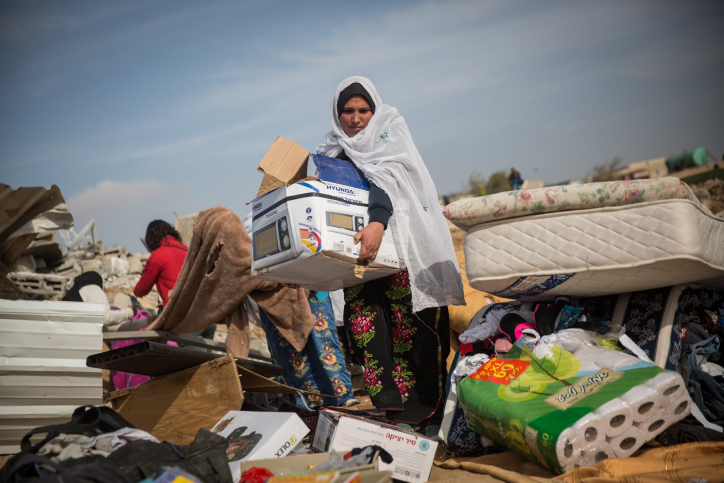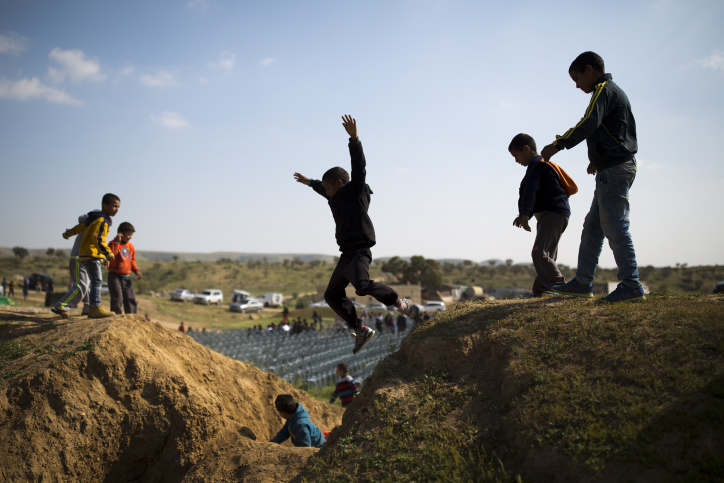Israeli authorities have promised the courts that the displaced Bedouin residents would have an opportunity to live in the new community. New documents show that is far from the case.

Despite assurances made to Israel’s High Court of Justice, a new town being built on the ruins of a Bedouin village in southern Israel is intended for Jews only, according to the bylaws of the future town’s cooperative association.
Israel first notified the residents of Umm al-Hiran, Bedouin citizens of Israel, that it plans to demolish their entire village and build another community in its place 15 years ago. A legal battle has been taking place ever since, although Israel’s top court ultimately approved the plan — partially based on assurances that the current Bedouin residents would have the option of living in the new community.
According to the bylaws of Hiran, the future Jewish town, which were uncovered by “Adalah — The Legal Center for Arab Minority Rights in Israel,” acceptance into the community will be open only to “Jewish Israeli citizens or permanent residents who observe the Torah and the commandments according to the values of Orthodox Judaism.”
The National Planning and Building Council, which first approved the plan to build the town atop Umm al-Hiran, had promised it would be open to all Israeli citizens, regardless of religion or nationality. The High Court took the state at its word when it claimed Bedouin would be allowed to live in a future Hiran.
Adalah Attorney Myssana Morany sent a letter to Israeli Attorney General Avichai Mandelblit on Monday, demanding he prevent the allocation of plots in Hiran to the “core” group of the town’s cooperative association, and ensure that Umm al-Hiran’s current residents are included in the new town’s planning.
Israeli law offers two seemingly contradictory stances on ethnic or religious housing segregation. On the one hand, the state cannot discriminate in the allocation of land to its citizens. On the other hand, communities are allowed to exclude would-be residents if they would alter the character of the community — meaning they can discriminate on any number of grounds.

Prior to Israel’s founding in 1948, Umm al-Hiran’s residents lived northwest of where the village currently stands. Like many Bedouin, they were expelled during and after the 1948 war, and like most Arab citizens of the nascent Jewish state, they were placed under strict martial law until 1966.
In 1956, the local military governor forcibly relocated the villagers to their current location. Their original land was expropriated by the state in order to establish Kibbutz Shoval.
Despite being established by virtue of an Israeli military order, Israel has never actually recognized Umm al-Hiran, and has therefore never provided it with any basic services or infrastructure such as water, electricity, health services, or schools.
The Israeli government now wants to move the residents of Umm al-Hiran to the nearby urban area of Hura, one of seven townships built to concentrate Bedouin villages in the area.
For several years now, religious Israeli Jews — who form the founding “core” of the cooperative association that is to run the new town of Hiran — have been living in JNF-sponsored caravans, which are connected to water and electricity, in the nearby Yatir forest, as they await the demolition of Umm al-Hiran.
Construction of Hiran began in mid-2016, when the state, along with the Jewish National Fund (JNF), began breaking ground just meters from the Bedouin villagers’ homes.

The Israeli government has made several attempts in recent years to “formalize” land ownership in the Negev, where the vast majority of Israel’s Bedouin population lives. The goal is to “Judaize” the Negev — that is, build more Jewish towns in areas that are populated by non-Jews.
In 2013, the Prawer Plan, which sought to forcibly relocate some 40,000 Bedouin citizens living in dozens of so-called unrecognized villages, was scrapped following immense pushback by Bedouin residents and activists.
Dispossession in plain sight
As my colleague Amjad Iraqi previously noted on these pages, segregation is not a new phenomenon in Israel: it has been embedded deep in the DNA of the state since its establishment. Through legislation that allowed the expropriation of land owned by Palestinians who fled or were expelled in 1948, along with policies of quasi-governmental organizations such as the JNF and Jewish Agency, Israel has been working tirelessly to secure maximum control of land for Israel’s Jewish citizens. Meanwhile, it has done its utmost to contain the spread of Palestinian communities through home demolitions, discriminatory planning, and unequal resource allocation. Aside from seven Bedouin townships, not a single town or city has been built for Israel’s Arab population since 1948.
In a sense, the saga of Umm al-Hiran brings the story of Israel’s discriminatory land regime full circle. Like dozens of other Arab villages, Umm al-Hiran’s residents were first expelled to make room for a kibbutz. The calculus of the Israeli leadership in the 1940s and 50s was that new Jewish communities — kibbutzim, moshavim, development towns, and cities — would be built atop Palestinian villages depopulated during the Nakba in order to prevent the return of refugees, to act as buffers on the frontiers of the new state, and to prevent the remaining Palestinian towns and villages from expanding.
Today, however, the state no longer needs to hide behind those excuses to displace its Arab citizens and take their land. Today, the state can simply advance plans that deprive one set of citizens of their rights and their homes, simply to benefit another set of — Jewish — citizens.

